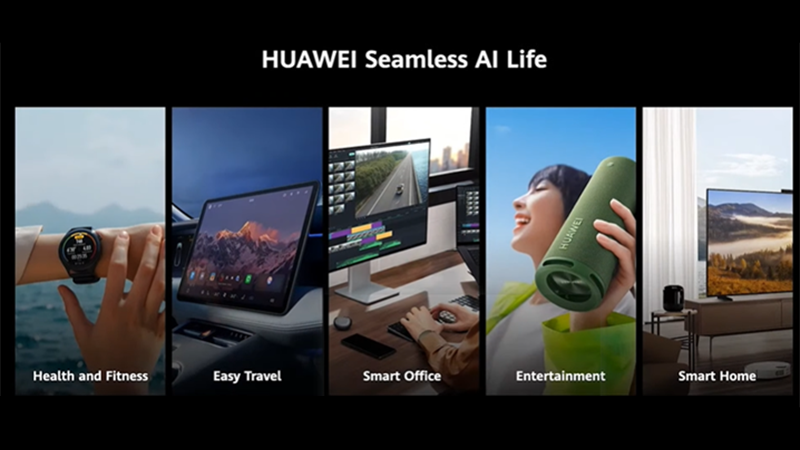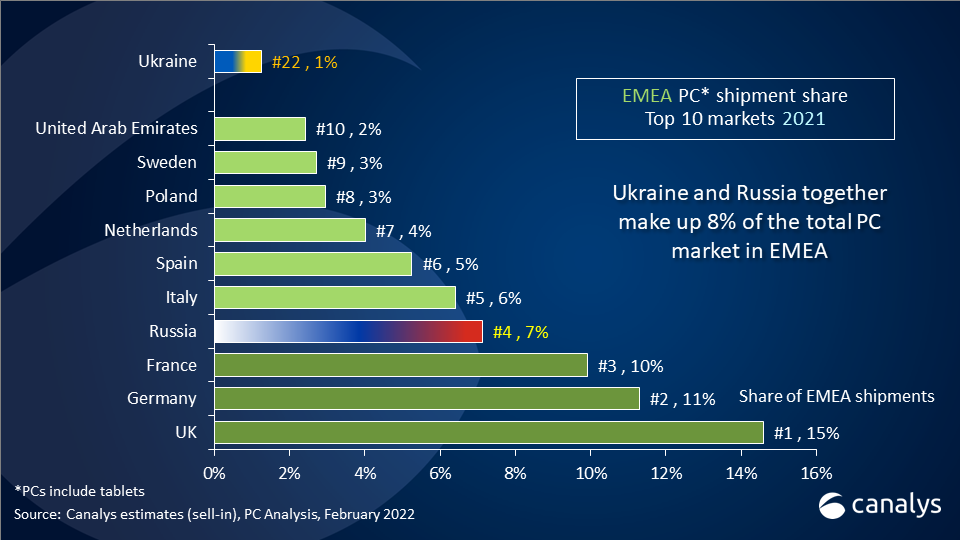
Huawei’s Smart Office – comprehensive strategy or just hype?
Huawei announced its Smart Office lineup, including five PC products, at MWC Barcelona 2022. Due to current constraints on its smartphone business stemming from US sanctions, Huawei has increased its focus on its nascent PC offerings, but improvements in both technological capabilities and go-to-market strategy are still needed to ensure success.
The background to Huawei’s Smart Office launch
At MWC Barcelona 2022, Huawei unveiled seven new Smart Office products: a flagship notebook, a new two-in-one notebook, its first all-in-one desktop, an e-ink tablet, a new MatePad, a printer and a smart speaker. Its Smart Office strategy, a subset of its “1+8+n” strategy, which was launched in 2019, is to create strong connectivity across its broad range of products. Huawei’s “Super Device” concept allows users to work and share documents across Huawei’s smartphones, tablets, PCs and IoT products. Among the PC products, its first all-in-one PC, the MateStation X, and its e-ink tablet were the most eye-catching, designed to compete with Apple’s iMac and Amazon’s Kindle. This is a bold move but understandable given the situation of its current consumer business.
Since 2019, the United States has levied sanctions against Huawei, prohibiting Google and TSMC from providing Google Mobile Services (GMS) and advanced chipsets respectively. Huawei’s consumer devices business was severely affected, especially in overseas markets, where users have a strong attachment to GMS. Though Huawei has officially announced Harmony OS as a substitute for GMS and started to invest more in other business units, a slump in sales has been unavoidable. Given this dilemma, boosting its PC business with a comprehensive Smart Office strategy is seen as a way to offset losses incurred elsewhere.
Connectivity and interoperability across PC products a key focus for Huawei’s Smart Office
Huawei’s product series extends connectivity by promoting interoperability between PCs, tablets and smartphones. The core concept of its Smart Office is seamless connectivity, allowing for transfer and cross-operation between its supported products without cables. For example, a user can shoot a video or take a photo with their smartphone or tablet and then share the result by dragging it to a MateStation or MateBook Pro to do the post-production work. With the e-ink tablet, a user can record and transcribe a meeting and then edit it on their tablet or phone or transfer written content from their smartphone or tablet and read it on the MatePaper’s ink screen. These innovations are working toward bridging the connectivity limitations of an individual device to differentiate from competitors. Beyond flexible connectivity features, Huawei is also touting the use of touch-screens and styluses on its desktops and notebooks, which is naturally attractive for creative use-cases. These software and hardware features, along with competitive pricing, give the MateStation X and MatePaper a chance to compete with Apple’s iMacs and Amazon’s Kindles.
Huawei’s first all-in-one and e-ink tablets target established markets
By launching Smart Office, Huawei is targeting an established market where a strong dominance is yet to be established, in an era speeding toward hybrid work. Apple’s iMac customers value the machines’ strong capabilities in graphics and video processing, the ecosystem and the user experience. Despite Apple’s competence and experience and its strong capabilities in developing its in-house M1 chipset, the high price and incompatibility with mainstream office platforms are barriers to large-scale adoption of the iMac. Canalys estimates that Windows held over 83% of the PC market globally in Q4 2021, which indicates a large market potential for Huawei’s PC products, if they can deliver compelling features and user experiences. The MatePaper varies from Amazon’s Kindle but with revolutionary functions in cross-device connectivity. Kindle does have strong competence in its content resources and community while other players are far behind. Huawei won’t be competitive in this sense, but cross-device transfer of content helps to make up for this shortcoming. More importantly, by building on competitors’ product concepts and injecting new functionality, Huawei avoids the risks and costs of market verification.
Smart Office gives Huawei an experimental pathway to bypass sanctions
Huawei is trying to sidestep the constraints on its ecosystem and components with innovative products and solutions in an adjacent market. Compared with Huawei’s smartphone and IoT products, PCs have a lower reliance on GMS and 5G penetration but have a strong reliance on the Windows operating system and Intel and AMD chipsets. Huawei can form partnerships with Microsoft, Intel and AMD to promote its notebook and desktop business as other PC OEMs have done. Huawei stands to benefit not just from direct revenue but also by growing its user base and improving its connectivity functions and technologies to differentiate. Having the PC at the heart of its user experience in smart connectivity and interoperability is vital for forming a holistic ecosystem for productivity.
Smart Office is an unproven solution and a limited concept with lots of challenges
Huawei’s offering currently suffers from some issues that it must resolve. Its cross-device user experience is still flawed as it only supports limited devices and operations, and the user interface is not consistent across PCs and smartphones. Additionally, there are latency issues around transferring and operability across devices. At the same time, huge challenges lie ahead for Huawei relating to its OS and ecosystem. It must attract more software developers to its community. It recently announced at its annual report press conference that it had around 8 million developers, and it must convince users to switch from GMS and iOS.
Most of Huawei’s tablets and smartphones come pre-installed with Harmony OS. But consumers outside of China are still highly reliant on GMS, including Google Play Store, Google Maps, YouTube and Google Cloud. It won’t be easy in the short term for Harmony OS to replace the deeply embedded applications that Google and Apple have invested in for years. Furthermore, simply offering connectivity and cross-device operations is not a comprehensive solution. There are more functions required for a real smart office, such as boundless collaboration and interaction, intelligent control and management, and optimal ecological footprints that promote productivity and efficiency in emerging workstyles. Therefore Canalys believes Huawei’s Smart Office solution is very much a work in progress, with significant improvements needed to truly challenge. Finally, a clear go-to-market strategy for Huawei’s Smart Office solution is still lacking. Plans around channel partnerships and bundling of the solution’s products in overseas markets are yet to be formed. These decisions will be at least as important as technological competency in determining Huawei’s success.
Share this article
CATEGORY
- All
- Canalys Forums
- Canalys Forums,Channels
- Canalys Forums,Channels,Partner Program
- Canalys Forums,Channels,Sustainability
- Canalys Forums,Sustainability
- Enterprise
- Market
- Market,Canalys Forums,Channels
- Market,Canalys Forums,Channels,Cloud
- Market,Canalys Forums,Channels,Sustainability
- Market,Channels,PC
- Market,PC
- Market,Smartphone
- Market,Technology,AR/XR/VR
- Market,Technology,Automotive
- Market,Technology,Canalys Forums,Channels
- Market,Technology,Canalys Forums,Channels,Cloud
- Market,Technology,Channels
- Market,Technology,Channels,Cloud,Partner Program
- Market,Technology,Smart Personal Audio
- Market,Technology,Smart Speaker
- Market,Technology,Smartphone
- Smart Personal Audio
- Smartphone
- Technology
- Technology,Canalys Forums,Channels,Security
- Technology,Channels
- Technology,Channels,Cloud,Partner Program
- Technology,Channels,Partner Program
- Technology,Unified Communications
- Technology,Wearable Band

